-

人教版新目标初中英语八年级下册He said I was hard-working教案2篇
This activity introduces some new vocabulary and provide oral practice using the target language.Task 1 . Ask four students to stand in front of the class, and the teacher asks them the following questions as a reporter.1.What are you going to do when you grow up?2.What are you going to do next week?3.What are going to do after school?The students will give different answers, then ask a good student to report what they said.I am going to e a doctor.What did she say?----------She said she was going to be a doctor.I am going to have a party on Friday night.What did he say?-------He said he was going to have a party on Friday night.I am going to do my homework.What did she say ?------ She said she was going to do her homework.I am going home after school.What did she say?-----She said she was going home after school.Say In this unit we are going to learn to use words like to report what someone said.Task 2. Read the instructions. Then ask a student to read the four questions. And write the words on the Bb. Explain what soap opera is.Task 3. Ask the students to Look at the pictures, point out the TV screens in the picture. Ask one girl to read what Marcia said.What did Marcia say? She said She said she was having a surprise party for Lana on Friday night. Repeat the other pictures in the same way.Activity3. Listen and number the pictures in activity 1a.

人教版新目标初中英语八年级下册What were you doing when the UFO arrived教案2篇
(一).知识方面: 1.培养学生能运用过去进行时来描述、谈论过去某个时间正在发生的事情或动作的意识和能力,能就过去某个时间正在发生的动作做出正确的描述。 2.培养学生的想象力和角色扮演的合作能力。 3.培养学生讲述过去发生的事情经过的能力。能正确运用一般过去时来讲述故事。 (二).技能方面: 1.本单元的语言目标是Talk about past events and tell a story(谈论过去的时间和讲述一个故事),围绕这一目标,要涉及句型: What were you doing when the UFO arrived? ----I was sitting in the barber’s chair. The barber was cutting my hair. 因此必须学习standing、studying、cleaning、sleeping、cooking、making、eating、cutting、等表示地点的词,以便为上述句型提供语言材料。2.学习过去进行时的有关知识。Was/were+现在分词,是该时态的表达式。 3.在学习过程中,要区分The boy was walking down the street when the UFO landed.和While the boy was walking down the street, the UFO landed.这两种由when和while引导的状语从句的句型结构。注意它们的不同。

人教版新目标初中英语七年级下册How was your weekend教案2篇
Teaching Goal:1. General aims:Talk about recent past events2. Particular aims:A. Language Focus.Talk about recent past events and think of the past events.B. Language goalsHow was….?It was …What did …do over the weekend?C. Language structures:(1). How was your weekend? I was great. Pay attention to no form.(2). What did you do over the weekend? I played soccer. We went to the beach.D. Useful words and phrases:Words: was, did, went, beach, over, project, test, wasn’t, false, number, geography, spend, week, most, mixture, their, had, little, cook, read, saw, change, everyone, sit, sat, no, anythingPhrases: did one’s homework, played soccer, cleaned my room, went to the beach, played tennis, went to the movies, on Saturday morning, over the weekend, cook … for, what about, do some reading, have a party, talk show, go shoppingE. Grammar language:Present simple past tenseRegular and irregular verbsF. Learning strategies:Tour and holidaysG. Interdiscipinary:H. Emotion and manner:Teaching time: 5 periodsTeaching procedures:Period One教学步骤、时间 教师活动 学生活动 媒体应用Step 1Free talk 3’ Ask some questions like:Who’s on duty today?What’s the weather like? Answer and talk about something.让同学们回答下列问题1. Do you like weekend? (Let some students answer)It takes them three minutes to talk about the question.2. Why do you like weekend? (let the students answer) Most of the students like the weekend此时教师用汉语问:“在周末期间问你干了什么?这句话用英语这么回答?Let the students guess.At last the teacher give them right answer3. What did you do over the weekend?(板书、学习)

人教版新目标初中英语七年级下册Where is the post office教案2篇
Period 2 (3a----Section B 2c)Preview(Pre-task): Key points: What laAdd another information about their pen pals----their language on the cardnguage does she/he speak?She/He speaks....Does she/he have any brothers and sisters? Does she/he speak English?Preview(Pre-task): Add another information about their pen pals----their language on the cardKey points: What language does she/he speak?She/He speaks....Does she/he have any brothers and sisters? Does she/he speak English?Step 1 Revision1.Revisionand dictation of the new words 2.Revise the drills they learned yesterday.(by pairwork and grammar exercise)Step 2 Leading-inT has a conversation with one student. The conversation is following:---Do you have a pen pal?---Yes, I do.---What's your pen pal's name? ---His/Her name is....---Where is your pen pal from? ---He/She is from...---Where does he/she live? ---He/She lives in....---What language does he/she speak?He/She speaks...Write the new words on the Bb. They are following: EnglishChineseJapaneseFrenchStep 3 LearnLearn the new words with the whole class.Finish 3a with the students3b Pairwork T still does an example with one student Then the Ss practise in pairs. The example is following:--Curry Muray is my pen pal. He is from the United States.---What language does he speak?

人教版新目标初中英语七年级下册Don’t eat in class教案2篇
Don’t fight. =You can’t fight. (板书,教读)教师把这些句子板书在黑板上,并请学生大声整齐地读祈使句和“can’t”句型,并让学生注意两种句型表达形式的不同和转换,“Don’t …=You can’t…”;并对学生说:These are our school rules. (板书,教读) You can’t break the school rules. Don’t break the school rules.(板书,教读)步骤3 :Practicea. T: Now, each of the students is breaking one of these rules.Please finish 1a.学生看图,完成1a的内容,检查答案并大声朗读校规。b. 听录音,完成1b,选出四位学生都违反了哪条校规;听之前,学生要读会英文名。c. 请两位学生朗读1c部分的句型;要求学生两人一组对话表演,SA扮演外校转来新生,SB告知本校校规。(学生可经过讨论,多说出他们想到的校规,不必只限于书上;教师应给予帮助)2) 第二课时(2a~4)步骤1 :warming up of revisionT: What are the rules at your school?学生使用“can”或祈使句表达各条校规;其中老师可引出“eat in the cafeteria outside”的表达。步骤2 :Practicea.T: Christina is an exchange student. She doesn’t know the rules. Let’s listen, what activities they’re talking about?学生听第一遍时,完成2a;第二遍时,完成2b;b. 请学生领读2c部分,看着2a完成的表格,理解2c活动的要求;分成小组针对2a进行问答;

人教版新目标初中英语七年级下册Why do you like koalas教案2篇
单元整体说明(一)单元教材分析本单元的核心话题是描述动物和表达个人喜好,以及句式why do you like…? Because…。这也是本单元的教学重点。通过本单元的学习,学生应能较流利地运用所学词汇和句型描述动物,表达个人喜好。(二)单元知识结构1.词汇动物名称 tiger, elephant, koala, dolphin, etc.词汇描述性形容词: smart, cute, ugly, clever, shy, etc.国家名: Australia, South Africa2.句型Why do you like koala hears? Because they are cute.Where are pandas from? They're from China.What animals do you like? I like dolphins.(三)单元整体目标1.Master the vocabulary2.Master and use: Why do you like koalas? Because they am cute.Where are pandas from? They're from China.What animals do you like? I like dolphins.(四)单元教学重难点一览(五)单元学情分析学生此前已经学过由why, where, what 引导的特殊疑问句句型,具有了学习本单元知识的认知前提。形形色色的动物能激发学生的好奇心,产生了解它们的欲望,这有利于本单元知识的教学和学生学习兴趣的培养。

人教版新目标初中英语八年级下册What should I do教案2篇
说明:在帮Li Lei提建议的同时,教育学生如何学好英语。第三课时教学目标1. 语言目标:a) 词汇: Original, in style, haircut, the same as.b) 语言结构:My friend wears the same clothes and has the same haircut as I do.2. 能力目标:大多数学生能够谈论自己喜欢哪种服装,提高查找信息的能力。3. 情感目标:学会如何与朋友相处,要有自己对时尚的看法。教学重点掌握一些重要词汇。教学难点学会谈论问题,并能提出书面建议。◆教学突破首先针对Erin的问题,提出个人的建议,模仿2c部分的对话展开双人交际Pair-work;听老师诵读3a部分的信件,并找出LEFT OUT的问题所在;学生完成3b部分的内容,给Left Out提出书面的建议;学以口头形式提出自己目前存在的某个问题,讲给大家听,让同学们给自己提出一个建议,并作笔录;学生两、三个人分成一组,随意性地进行口语交际,谈论P14的第4部分的某个问题,相互交换意见。

人教版新目标初中英语八年级下册If you go to the party, you’ll have a great time教案2篇
区分宾语从句、定于从句和状语从句宾语从句和状语从句,都叫做主从复合句。宾语从句主要是中考必考的,是初中阶段必掌握的从句,宾语从句主要是掌握三要素,所谓宾语从句,就是宾语在主从复合句当中充当宾语的一个句子,叫做宾语从句。主句的谓语动词是及物动词,后面如果是词或者是短语的话,是简单句,如果是句子的话,肯定是宾语从句。I know that he good at English.就是宾语从句,三要素,一要素是要注意连词,连词一共学了三类连词,一类连词是that口语当中可以省略,就像刚才说的那一句,I hear he is good at English.还有疑问代词、疑问副词,how where when,疑问代词、疑问副词。还有一类连词weather是否的意思,不是状语从句当中的如果,这一定要和如果区分开,这是是否。I don't know if he interested at English。宾语从句要注意if是连词。第二要素是语序,要用陈述举语序。比如说你家有几口人,我们都说How many people are there in you family?但是这是简单句,一旦说成宾语从句,你可以告诉我你家有几口人吗?Could you tell me how many people there are in you family ?

人教版新目标初中英语八年级下册How long have you been collecting shells教案2篇
Step Ⅱ Show the new words on the screen and teach the new words. Read the new words to students and ask them to repeat.Step Ⅲ 3aThis activity introduces new vocabulary and provides reading practice using the target language.In this activity first look at the four pictures.T: What can you see in the pictures?Ss: Four snow globes.T: Right. There are four snow globes in the pictures. And what are they?Ss: They are a monster, two polar bears, two penguins and a birthday cake.Write these words on the blackboard: snow globe; monster; polar bear; penguin and birthday cake. Read them to the class and ask students to repeat each one. Make sure students understand each word.Use a computer to show the E-mail message on the screen and read the message to students.Get students to read the e-mail on their own, and then draw lines connecting each snow globe and its description.Correct the answers.AnswersA line should connect each snow globe picture with the words that describe it in the letter.Step Ⅳ 3bThis activity provides writing practice using the target language.First review Activity 2a on Page 47.Then ask students to complete the message according to Activity 2a.Some partial sentences are given to students. Write about one person's collection.When students work, walk around the room checking the progress and offering help as needed.When they finish, ask some students to read their messages to the class.

人教版新目标初中英语九年级下册We’re trying to save the manatees教案2篇
本单元主要围绕着有关濒临灭绝的动物这一话题,学习了应该怎样保护我们的环境,以及就某一问题展开辩论。目标提示语言目标能够运用所学知识,就某一问题展开辩论。认知目标1、复习一些语法:现在进行时、一般现在时、用used to 表示一般过去时、现在完成时、一般过去时的被动语态。2、学会表达同意和不同意。3、学会以下基本句型:We’re trying to save the manatees.Manatees eat about 100 pounds of food a day.There used to be a lot of manatees.In 1972,it was discovered that they were endangered.Some of the swamps have become polluted.情感目标了解一些濒临灭绝的动物的生活习性和濒临灭绝的原因,教育学生应该如何保护环境。教学提示充分利用多媒体等教学设备,创设与本课话题相关的情境,如各种不同种类的动物、动物园以及有关环境的画画等等。围绕着本单元的教学目标,设计一些贴近学生实际的教学任务,如让学生谈论自己最喜欢的动物,如何拯救濒危动物,如何保护环境等等。让学生根据所学知识,就动物园是否对动物有利以及其他的话题进行辩论。
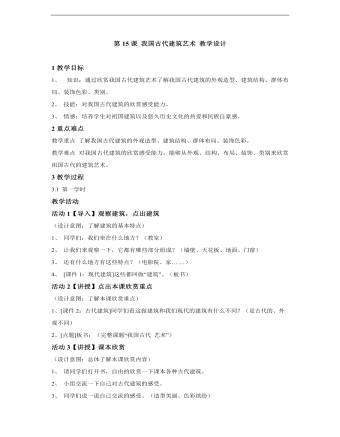
小学美术人教版六年级下册《第15课我国古代建筑艺术》教学设计说课稿
2重点难点教学重点了解我国古代建筑的外观造型、建筑结构、群体布局、装饰色彩。教学难点对我国古代建筑的欣赏感受能力,能够从外观、结构、布局、装饰、类别来欣赏祖国古代的建筑艺术。3教学过程3.1 第一学时教学活动活动1【导入】观察建筑,点出建筑(设计意图:了解建筑的基本特点)1、同学们,我们坐在什么地方?(教室)2、让我们来观察一下,它都有哪些部分组成?(墙壁、天花板、地面、门窗)3、还有什么地方有这些特点?(电影院、家… …)4、 [课件1:现代建筑]这些都叫做“建筑”。(板书)
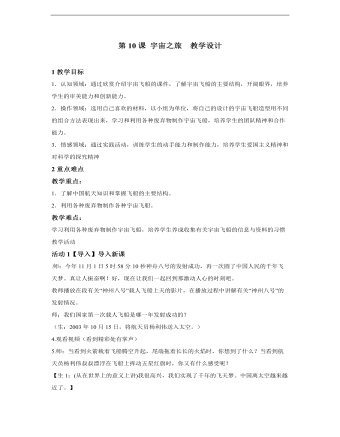
小学美术人教版六年级下册《第10课宇宙之旅》教学设计
2重点难点教学重点:1.了解中国航天知识和掌握飞船的主要结构。2.利用各种废弃物制作各种宇宙飞船。教学难点:学习利用各种废弃物制作宇宙飞船,培养学生养成收集有关宇宙飞船的信息与资料的习惯教学活动活动1【导入】导入新课.师:今年11月1日5时58分10秒神舟八号的发射成功,再一次圆了中国人民的千年飞天梦。真让人振奋啊!好,现在让我们一起回到那激动人心的时刻吧。教师播放在段有关“神州八号”载人飞船上天的影片,在播放过程中讲解有关“神州八号”的发射情况。

部编人教版四年级下册《 巨人的花园》精彩片段说课稿
师:巨人看见孩子们在花园里玩耍,大声叱责。请把巨人叱责的话找出来读一读。(生边读边画出巨人叱责孩子们的语句,文中主要有三句)师:读一读这三句话,联系上下文想一想:巨人说这些话的时候,心里可能是怎么想的?他说话的时候可能是什么样子的?生:巨人说:“你们在这儿干什么?”这时他可能瞪着眼睛,脸上通红通红的,双手叉着腰,心里想:这是我的花园!你们这些小家伙随便进来,真讨厌!生:巨人说:“我自己的花园就是我自己的花园。”这时候,比他刚回来时更烦,样子更凶。巨人肯定在想:我孤独地度过了漫长的寒冬,好不容易才盼来春天,你们这些小家伙又来了!这时,他可能攥着拳头,唾沫飞出老远。生:“除了我自己以外,我不允许任何人在里面玩。”巨人心里可能想,这是我的地方,我已经说了不让你们进来,你还敢进来!巨人说不定已经迈开大步准备去教训这个小男孩。
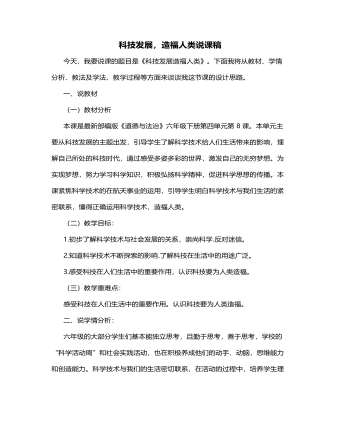
人教部编版道德与法制六年级下册科技发展,造福人类说课稿
3.科学的佐证:伽利略望远镜播放视频:《不说不知道,17世纪的伽利略用这和望远镜证实了日心说》。4.指名交流:伽利略的望远镜对当时有何意义?5.出示资料:伽利略遭到教会的谴责和审判。思考:哥白尼和伽利略在追求真理的过程中表现出了怎样的精神?活动二:伟大航行1.了解我国古代对宇亩的认识:天圆地方说。2.航海家的积极探索:你知道哪些著名的航海家?收集相关资料,说说它们的故事。根据交流出示相关资料。3.整理15世纪初开始的航行大事。4.观看视频,师生讨论:新航路的开辟有哪些作用?5.小结活动三:对自身的认识1.过渡:人类在认识自然界的同时,也在不断深化对自身的认识。2.人类起源的说法:(1)神创论:你了解哪些关于神创作人类的故事?(2)自然进化论,也就是大家比较认可的一和说法,人是从张猴进化而来的。
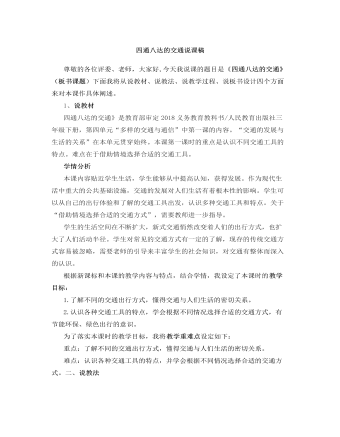
人教部编版道德与法制三年级下册四通八达的交通说课稿
1.宇涵同学音频说出自己出行困扰。2.小组合作讨论设计往返旅游线路:宇涵同学渴望大家的帮助,就请小组成员一起合作,帮宇涵设计一份往返旅游线路,我这里有一份从南京到大连的不同交通工具所需时间及费用的参考表。小组讨论,并将小组一致认为最适合的设计方案,写在设计表中!3.各小组派代表分享设计方案4.设置情境,学以致用:同学们设计的方案都很好,如果从我们目前所在的城市,到宇涵的家乡“南京”你又会如何选择?5.小结:看来,同学们都能根据自己不同的需求选择合适的出行方式。活动二:了解传统交通方式的作用1.观察思考:在我国,一些地区至今还沿用着传统的交通工具(出图),大家仔细观察,想一想,为什么它们能沿用至今?你还知道哪些传统的交通工具?2.小结:是呀,无论时代如何变迁,现代交通工具多么发达,都要选择适合我们的交通工具。在享受它们带来的便捷时,做到绿色出行,减少拥堵污染,那我们的生活一定会更加美好。
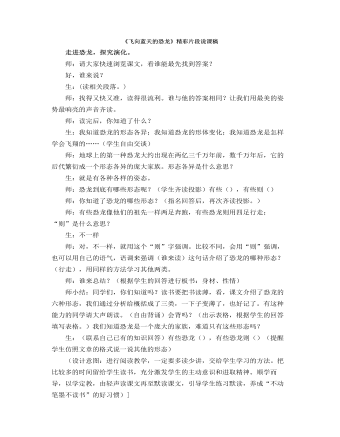
部编人教版四年级下册《 飞向蓝天的恐龙》精彩片段说课稿
师:是呀。早在19世纪,英国学者赫胥黎就注意到恐龙和鸟类在骨骼结构上有许多相似之处。在研究了大量恐龙与鸟类化石之后,科学家们提出,鸟类不仅和恐龙有亲缘关系,而且很可能就是一种小型恐龙的后裔。但相关化石一直没有找到。直到20世纪末期生:在课文中找出相关段落齐读。师:(投影出示再读)你读懂了什么?生:我知道了化石是首次发现,是在辽西发现……(学生交流)师:欣喜若狂,是什么意思?生:高兴到了极点,就要发狂了。师:研究者们为什么会如此地高兴?(设计意图:由点带面,通过重点词语的理解,感受科学家的艰辛与执着。)
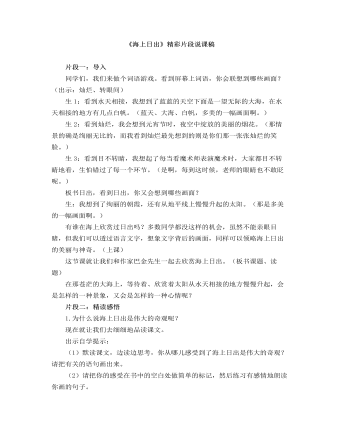
部编人教版四年级下册《海上日出》精彩片段说课稿
师:少了这两个词行不行?(不行。)为什么?生:转眼间写出了颜色变化的速度快,慢慢是指红霞扩散的速度慢。所以不能少了这两个词。师:既然颜色的变化是有快有慢,那我们在朗读的时候,速度也应该是——(有变化的 )。谁能带着你的感受来读一读。男生读。(你的朗读,让我们感受到了天空中色彩的瞬息万变。)女生读。(你甜美的朗读让我们感受到了红霞在天空慢慢晕地扩散。)齐读,透过文字,你能想象到什么样的画面?生:那浅蓝的天空和慢慢扩散的红霞让我感到这时的天空就好像是一幅美丽的水墨画。师:到底是学画画的孩子,有丰富的想象力。作者抓住了天空中颜色和光的变化,让我们感受到了海上日出是——生:伟大的奇观。(板书:颜色 光亮 变幻)看到天空中色彩的变幻以及那越来越亮的光,我知道——生:太阳要从天边升起来了,便不转眼地望着那里。透过“不转眼”你能体会到什么?(作者期待、盼望的心情。 生怕错过日出的每一个时刻。)是啊,此时,我们和作者的心情是一样的。
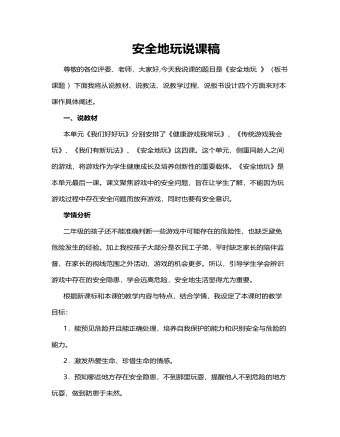
人教部编版道德与法制二年级下册安全地玩说课稿
任务1:(课件出示教材第32页图片)师:你们有没有面临过这样的危险,今后又要如何做呢?学生活动:学生讨论交流。教师小结:我们不仅要让自己远离危险,还要提醒他人注意安全。活动三:我们的安全提示牌任务1:我们在公共场所都见过安全提示牌,你觉得我们在学校的哪些地方也应该放置安全提示牌呢?学生活动:学生分组讨论。任务2:你认为安全提示牌上应写些什么话好呢?学生活动:学生讨论交流。任务3:除了学校,其他地方需要放置安全提示牌吗?请同学们试着制作一些安全提示牌。学生活动:学生制作安全提示牌,并放置在相应位置。课堂小结:通过本节课的学习,我们不仅发现玩耍的地方潜藏着危险,而且能够很好地认识到危险的程度,做到在保护自己的同时,提醒他人防范危险。
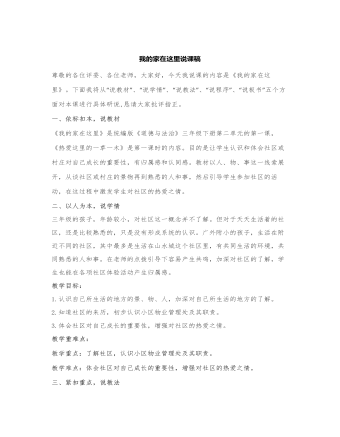
人教部编版道德与法制三年级下册我的家在这里说课稿
6.了解小区物业的职责。 7.小结:我们的家就在这里,它是那么的安全,那么的舒适。 通过播放社区生活小视频,让学生产生共鸣,体会到社区人们生活的和谐,并初步理解社区这一概念。 配音图片介绍物管的工作职责形象地让学生明白物管在我们和谐舒适生活中的重要作用,增加对社区的热爱之情。 活动四、社区活动我参与 1.回顾社区开展的活动。 2.社区活动大体验。 活动项目:猜灯谜 套圈圈 3.设计社区活动。 4.小结:我们的家就在这里,我们都愿意为社区出谋划策,因为我们都是社区的小主人。 创设情境,组织学生参加社区活动大体验,让学生再一次体会社区活动带来的快乐,明白社区工作人员为我们和谐生活做出的努力,增加学生的幸福感。 设计社区活动是为了发挥学生的主人翁精神,鼓励他们参加社区建设,共建美好社区。
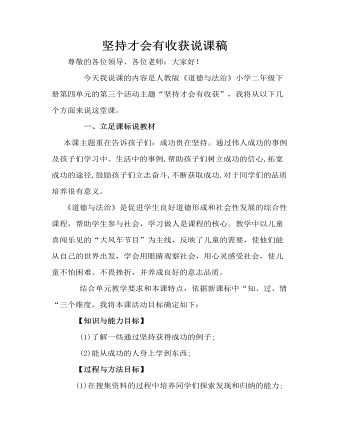
人教部编版道德与法制二年级下册坚持才会有收获说课稿
(二)、深化认识,付诸行动从上一环节的活动中,学生已经了解了一系列的“坚持才会有收获”的生动事例,本环节,就是让学生在“积极与消极意志品质的斗争中”引射出自已内心的情感。从而克服和纠正他们消极的意志品质,培养积极的意志品质,加深对“坚持才会有收获”的情感认识。并在“登山看海”的活动中,让学生扮演小青蛙,尝试体验青蛙要实现的目标虽不容易,但只要有毅力,克服困难努力坚持下去,最终就可以通过一小步一小步累计完成梦想,付诸于行动、见证了认识。(三)、方法指导,巩固延伸几种坚持下去的方式方法的介绍,便于孩子们课下体验尝试,对学生克服以后生活中遇到的问题和困难会有帮助。本节课在 “永不放弃”的歌声中结束,既能激发学生的奋斗意识,又能给学生留有回味的余地。